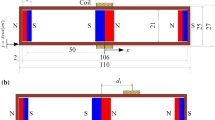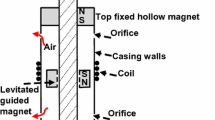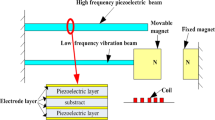Abstract
This study presents a new design of an electromagnetic energy harvester integrated with a soft magnetic material. The harvester design optimizes the magnetic material characteristics and the size of a rectangular permanent magnet. The design employs a complete magnetic circuit made of (1) a thin-film soft magnetic material that facilitates a flexible but highly (magnetically) permeable beam and (2) an optimally-sized magnet that maximizes the harvester performance. The design is demonstrated to reduce magnetic flux leakage, and thus considerably enhances both magnetic flux density (B) and its change by time (dB/dt), which both influence harvester performance. The improvement in harvester performances strongly depends on critical design parameters, especially, the magnet size and characteristics of magnetic materials, including permeability, stiffness, and thickness. The analyses conclude that recently-introduced nanomaterials (having ultrahigh magnetic permeability) can potentially innovate harvester performances. However, the performance may be degraded without design optimization. Once optimized, the integrated nanomaterials facilitate a significant improvement compared with a conventional design without integrated magnetic materials.
Similar content being viewed by others
References
S. Roundy, P. K. Wright and J. Rabaey, A study of low level vibrations as a power source for wireless sensor nodes, Computer Communications, 26 (11) (2003) 1131–1144.
D. Gunduz, K. Stamatiou, N. Michelusi and M. Zorzi, Designing intelligent energy harvesting communication systems, IEEE Communications Magazine, 52 (1) (2014) 210–216.
W. Chen, Y. Cao and J. Xie, Piezoelectric and electromagnetic hybrid energy harvester for powering wireless sensor nodes in smart grid, Journal of Mechanical Science and Technology, 29 (10) (2015) 4313–4318.
D. P. Arnold, Review of microscale magnetic power generation, IEEE Transactions on Magnetics, 43 (11) (2007) 3940–3951.
M. Salim, H. S. Sultan Aljibori, D. Salim, M. H. M. Khir and A. S. Kherbeet, A review of vibration-based MEMS hybrid energy harvesters, Journal of Mechanical Science and Technology, 29 (11) (2015) 5021–5034.
B.-C. Lee and G.-S. Chung, Low-frequency driven energy harvester with multi-pole magnetic structure, Journal of Mechanical Science and Technology, 29 (2) (2015) 441–446.
Q. Wang, Y. Zhang, N. X. Sun, J. G. McDaniel and M. L. Wang, High power density energy harvester with high permeability magnetic material embedded in a rotating wheel, Proc. of SPIE -The International Society for Optical Engineering(2012) 83470V-83470V-83476.
H. Wang, Y. Tang and A. Khaligh, A bridgeless boost rectifier for low-voltage energy harvesting applications, IEEE Transactions on Power Electronics, 28 (11) (2013) 5206–5214.
T. Galchev, H. Kim and K. Najafi, Micro power generator for harvesting low-frequency and nonperiodic vibrations, Journal of Microelectromechanical Systems, 20 (4) (2011) 852–866.
R. C. Vinod, M. G. Prasad and T. F. Frank, A coupled piezoelectric-electromagnetic energy harvesting technique for achieving increased power output through damping matching, Smart Materials and Structures, 18 (9) (2009) 095029.
I. N. Ayala-Garcia, D. Zhu, M. J. Tudor and S. P. Beeby, A tunable kinetic energy harvester with dynamic over range protection, Smart Materials and Structures, 19 (11) (2010) 115005.
M. El-hami, P. Glynne-Jones, N. M. White, M. Hill, S. Beeby, E. James, A. D. Brown and J. N. Ross, Design and fabrication of a new vibration-based electromechanical power generator, Sensors and Actuators A: Physical, 92 (1–3) (2001) 335–342.
X. Xing, G. M. Yang, M. Liu, J. Lou, O. Obi and N. X. Sun, High power density vibration energy harvester with high permeability magnetic material, Journal of Applied Physics, 109 (7) (2011) 07E514.
H. Chiriac, M. Tibu, N. Lupu, I. Skorvanek and T.-A. Óvári, Nanocrystalline ribbons for energy harvesting applications, Journal of Applied Physics, 115 (17) (2014) 17A320.
Carpenter Technology Corporation, Mu Metal Datasheet.
V. C. Valchev and A. V. d. Bossche, Inductors and Transformers for Power Electronics, CRC Press(2005).
C. Zheng, S. Yantao, X. Ning and T. Xiaobo, Integrated sensing for ionic polymer-metal composite actuators using PVDF thin films, Smart Materials and Structures, 16 (2) (2007) S262.
B. L. Ooi, J. M. Gilbert and A. R. A. Aziz, Switching damping for a frequency-tunable electromagnetic energy harvester, Sensors and Actuators A: Physical, 234 (2015) 311–320.
D. C. Hanselman, Brushless Permanent Magnet Motor Design, 2nd Ed., Magna Physics Pub.(2003).
T. Sato, K. Watanabe and H. Igarashi, Coupled analysis of electromagnetic vibration energy harvester with nonlinear oscillation, IEEE Transactions on Magnetics, 50 (2) (2014) 7007604 (7007604 pages).
M. E. McHenry and D. E. Laughlin, Nano-scale materials development for future magnetic applications, Acta Materialia, 48 (1) (2000) 223–238.
Nanocrystalline core materials for modern power electronic designs.
K. Najafi, T. Galchev, E. E. Aktakka, R. L. Peterson and J. McCullagh, Microsystems for energy harvesting, Proc. of International Solid-State Sensors, Actuators and Microsystems Conference (2011) 1845–1850.
C. Kim and J. Lee, Topology optimum design of unimorph piezoelectric cantilevered Mindlin plates as a vibrating electric harvester, Journal of Mechanical Science and Technology, 28 (10) (2014) 4131–4138.
M. Rahman and G. Slemon, Promising applications of neodymium boron Iron magnets in electrical machines, IEEE Transactions on Magnetics, 21 (5) (1985) 1712–1716.
Author information
Authors and Affiliations
Corresponding author
Additional information
Recommended by Associate Editor Heung Soo Kim
Sang Won Yoon received his B.S. degree in Electrical Engineering from Seoul National University, Seoul, Korea, in 2000; and his M.S. and Ph.D. degrees in Electrical Engineering and Computer Science from the University of Michigan, Ann Arbor, MI, USA, in 2003 and 2009, respectively. From 2009 to 2013, he was a Senior Scientist and Staff Researcher at the Toyota Research Institute of North America, Ann Arbor, MI, USA, where he conducted research in the fields of power electronics and sensor systems for automobiles. Since 2013, he has been with the Department of Automotive Engineering, Hanyang University, Seoul, Korea, where he is presently working an Assistant Professor. His current research interests include power electronics, sensors and sensor systems, electronic reliability, and their applications in both conventional and future vehicles.
Rights and permissions
About this article
Cite this article
Yoon, S.W. Numerical study and design optimization of electromagnetic energy harvesters integrated with flexible magnetic materials. J Mech Sci Technol 31, 2399–2406 (2017). https://doi.org/10.1007/s12206-017-0437-1
Received:
Revised:
Accepted:
Published:
Issue Date:
DOI: https://doi.org/10.1007/s12206-017-0437-1




